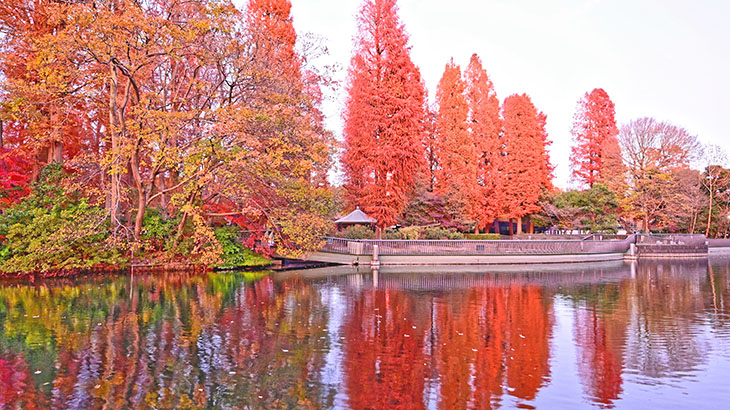In Japan, there are a lot of places where you can enjoy the maple scene. Here are 10 spots for beautiful maple scenes that you cannot afford to miss. Most of them are within 23 wards of Tokyo, which is convenient to visit, while two of them are in suburbs of Tokyo, which is good for a leisurely day trip.
BEST 10 Spots of Momiji (Maples) Scenes in Tokyo
With four distinct seasons in Japan, not only is the cherry blossom scenery in spring gorgeous, but the crimson and gold deciduous maples in autumn are also very impressive.
Starting from mid-September, color of the leaves dyes in red, yellow and orange gradually from area of Hokkaido to Kyushu till early December. Breathtaking colorful autumn foliage sceneries are immensely popular with all types of travelers, both local and overseas. The Japanese called these multicolored leaves "Koyo" or "Momiji."It is very popular for Japanese to take a short trip to enjoy the marvelous fall scenery, and many famous spots will be crowded with people.
As the peak viewing period for "Momiji" is just around a week, it is advised to research for an updated forecast of the best time. As it is a bit warm this year, it is anticipated that the color change of the leaves might be several days later than last year. Here is the forecast for the peak season of autumn leaves in different regions of Japan this year.
In Japan, there are a lot of places where you can enjoy the maple scene. It might be difficult for one to choose from. As per the forecast, the peak season for colorful deciduous maples in Tokyo will be around late November until early December. It is recommended to visit Tokyo during that period, as Christmas illuminations can also be enjoyed simultaneously.
Here below are 10 spots for beautiful maple scenes that you cannot afford to miss. Most of them are within 23 wards of Tokyo, which is convenient to visit, while two of them are in suburbs of Tokyo, which is good for a leisurely day trip.
-
-
-
(1) Tokyo Chuo Ward - "Hama Rikyu Garden”
(2) Tokyo Shibuya Ward - “Yoyogi Park”
(3) Tokyo Bunkyo Ward - “Rikugien Garden”
(4) Tokyo Bunkyo Ward - “Koishikawa Korakuen Garden”
(5) Tokyo Shinjuku Ward - “Meiji Jingu Gaien Park”
(6) Tokyo Shinjuku Ward - “Shinjuku Gyoen”
(7) Tokyo Suginami Ward - “Otaguro Park”
(8) Tokyo Katsushika Ward-“Mizumoto Park”
(9) Tokyo Musashino City and Mitaka City - “Inokashira Park”
(10) Tokyo Tachikawa City and Akishima City - “Showa Memorial Park”
-
-
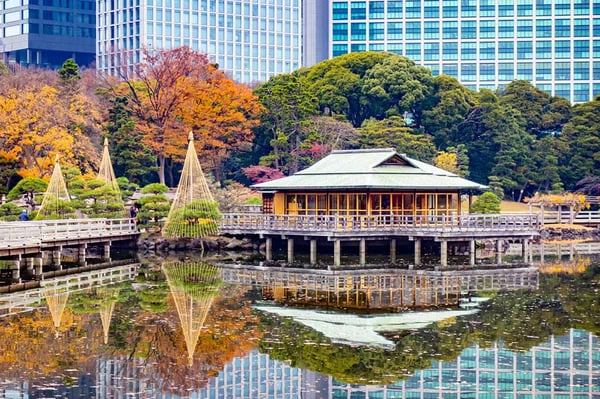
Chuo Ward is located at the center of Tokyo's 23 wards, where the business and economic center of Japan is located, with the headquarters of the Bank of Japan and Japan Exchange Group gathered in this ward. Famous areas like Ginza, Nihonbashi, and Tsukiji can also be found here. Chuo Ward covers an area of 10.21 square kilometers and has a population of around 170,000, ranking 21st in terms of area size and 22nd in terms of population size among the Tokyo 23 wards.
Hama Rikyu Garden is a very large and attractive Japanese-style garden located in the center of Tokyo. It was built in 1654, and the area is as large as five times the Tokyo Dome. It is the only Japanese-style garden in Tokyo with a seawater pond. It was originally built as a feudal lord's Tokyo residence and duck hunting grounds during the Edo Period, and nowadays some vestiges are still visible.
The garden scenery is signature with the teahouse on an island where visitors can rest and enjoy the nice environment around. With numerous maple and ginkgo trees around, the attractive fall colors fill the garden in autumn and draw people to take a walk along the trails inside the garden, which is especially good for those who just visited the Tsukiji outdoor market nearby.
|
Peak season |
Late November ~ Early December |
|
Open hours |
9:00 ~ 17:00 (16:30 last garden entry time) |
|
Access |
12-minute walk from JR Shimbashi Station (JR Chuo Line / Tokyo Metro’s Tozai, Yurakucho, Namboku Lines / Oedo Subway Line) |
|
Admission Fee |
500 yen |
- (2) Tokyo Shibuya Ward - “Yoyogi Park”
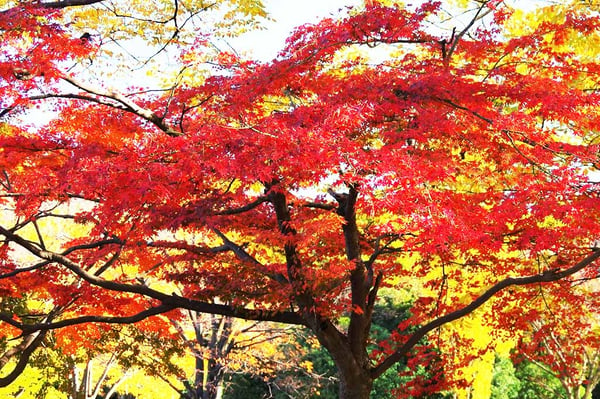
Shibuya Ward is located in the western part of Tokyo, and is one of the five central wards in Tokyo, along with Chiyoda Ward, Chuo Ward, Minato Ward, and Shinjuku Ward. Shibuya Station is one of the most important traffic hubs in Tokyo. Its most prominent landmark is the busy traffic intersection in front of the Hachiko Exit. The area surrounding the intersection is heavily decorated with neon advertisements and giant video screens, and always gets flooded by pedestrians each time the lights turn green, making it a popular photo spot in Shibuya. Shibuya Ward covers an area of 15.11 square kilometers and has a population of around 240,000, ranking 12th in terms of area size and 18th in terms of population size among the Tokyo 23 wards.
Yoyogi Park in Shibuya Ward is very extensive, with an area of 540,529 square meters, making it one of the five largest city parks in Tokyo. It is formerly served as the site of the 1964 Tokyo Olympic Village and is adjacent to the renowned Meiji Jingu (Shrine). The park is very popular among Japanese and overseas tourists as it is located close to the shopping spots of Harajuku and Omotesando. Besides, the beautiful natural scenery of sakura and maples throughout the year is another attraction of the park.
|
Peak season |
Late November ~ Early December |
|
Open hours |
The park is open all the time |
|
Access |
3-minute walk from JR Harajuku Station (JR Yamanote Line) 3-minute walk from Meiji Jingumae Station of Chiyoda Line / Fukutoshin Line of Tokyo Metro |
|
Admission Fee |
Free |
- (3) Tokyo Bunkyo Ward - “Rikugien Garden”
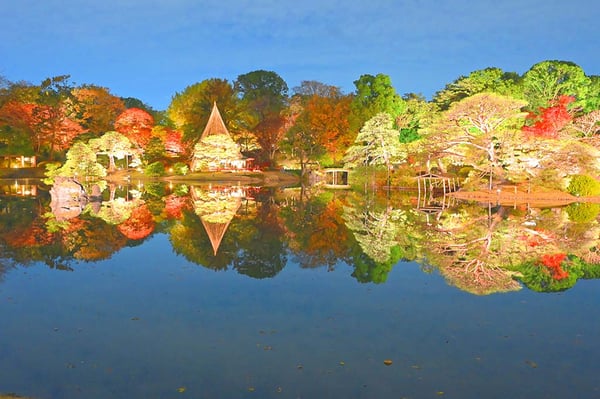
Bunkyo Ward is located in the north-central part of Tokyo. It is named Bunkyo because, other than being a residential area, the ward is also a cluster of cultural and educational institutions, like the campus of the top University of Tokyo (Hongo campus). Besides, the renowned Tokyo Dome, the well-known historic gardens – Rikugien Garden and Koishikawa Botanical Garden can also be found in this ward. Bunkyo Ward covers an area of 11.29 square kilometers and has a population of around 240,000, ranking 20th in terms of area size and 19th in terms of population size among the Tokyo 23 wards.
Rikugien Garden is one of the most beautiful Japanese-style landscape gardens in Tokyo. Built in 1702 for the 5th Tokugawa Shogun, the garden is a good example of an Edo Period strolling garden, which features a large central pond surrounded by manmade hills and forested areas. Together with small bridges, streams, trails, and nice teahouses, these features create breathtakingly beautiful scenery.
Rikugien is famous for its autumn colors. It is claimed to be one of the best autumn foliage scenes in Tokyo. The views are particularly beautiful around the stream around the bridge called Togetsukyo. One can enjoy the dyed yellow, red and orange leaves and take a stroll on a sunny autumn day. Besides, there is a lighting event during the peak season, and the night scene of deciduous maples is just gorgeous. The garden is just a 7-minute walk from Komagome Station (JR Yamanote Line). The location is very convenient, as it only takes around 6 minutes by train from JR Shinjuku station.
|
Peak season |
Late November ~ Early December |
|
Open hours |
9:00 ~ 17:00 (last garden entry time: 16:30) * Last entry time during night lighting period: 20:00 |
|
Access |
7-minute walk from Komagome Station (JR Yamanote Line). |
|
Admission Fee |
300 yen |
- (4) Tokyo Bunkyo Ward - “Koishikawa Korakuen Garden”
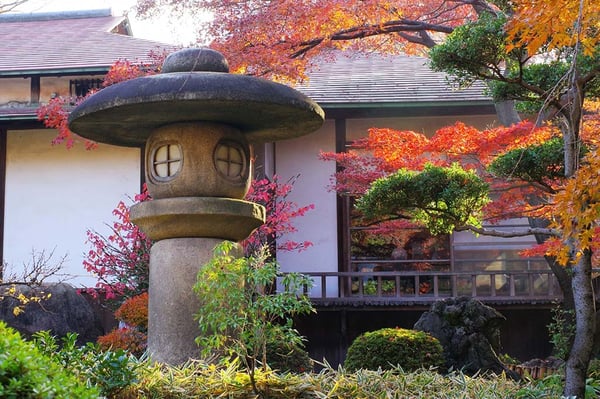
Koishikawa Korakuen Garden is located at the rear of Tokyo Dome and Koreakuen Amusement Park. In comparison to the surrounding modern architecture, the historical garden retains a beautiful natural landscape separate from urban Tokyo.
The traditional Japanese-style garden, which featured a pond, was built in 1629 as the Tokugawa family's residence during the Edo Period. Inside the garden, there are bridges, a variety of trees, ponds, streams, stones, and walking trails that visitors can enjoy the beautiful scenes around. The garden is extraordinarily awesome with autumn colors. Over 480 maple and ginkgo trees turn vibrant shades of orange, red and yellow in late November. A crowd of people is drawn to photograph the colorful fall leaves and enjoy the relaxing sensation in the garden.
|
Peak season |
Late November ~ Early December |
|
Open hours |
9:00 ~ 17:00 ( last garden entry time: 16:30) |
|
Access |
8-minute walk from Iidabashi Station (JR Chuo Line / Tokyo Metro’s Tozai Line, Yurakucho Line, Namboku Line / Oedo Subway Line) |
|
Admission Fee |
300 yen |
- (5) Tokyo Shinjuku Ward - “Meiji Jingu Gaien Park”
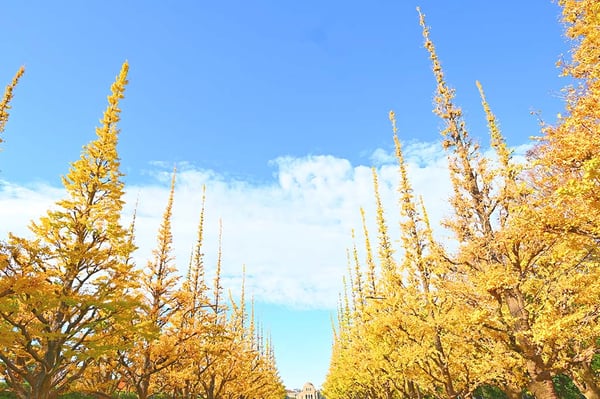
Shinjuku Ward is located in the west-central part of Tokyo, and is one of the five central wards in Tokyo, along with Chiyoda Ward, Chuo Ward, Minato Ward, and Shibuya Ward. Shinjuku Station is one of the most important traffic hubs in Tokyo and is also one of the well-known stations in Japan and abroad. Shinjuku Ward covers an area of 18.22 square kilometers and has a population of around 340,000, ranking 13th in terms of area size and 12th in terms of population size among the Tokyo 23 wards.
Meij Jingu Gaien Park is well-known for its golden autumn ginkgo tree scene. There are 146 ginkgo trees on both sides of the Jingu Gaien avenue, which stretches for approximately 300 meters from Aoyama Road. During the peak season in late November, the uniquely trimmed trees turn a brilliant golden color, which draws crowds of people to stroll under the leaves. Before COVID-19, there was a ginkgo festival with numerous food stalls and a night light-up event for people to enjoy. Meiji Jingu Gaien Park is the place that no one can miss for its fantastic golden ginkgo scenery and autumn atmosphere in Tokyo.
|
Peak season |
Late November ~ Early December |
|
Open hours |
The park is open all the time |
|
Access |
5-minute walk from Aoyama-itchome Station (Tokyo Metro Hanzomon Line) / 10-minute walk from Shinanomachi or Sendagaya Station (JR Chuo Line / Sobu Line) |
|
Admission Fee |
Free admission |
- (6) Tokyo Shinjuku Ward - “Shinjuku Gyoen”
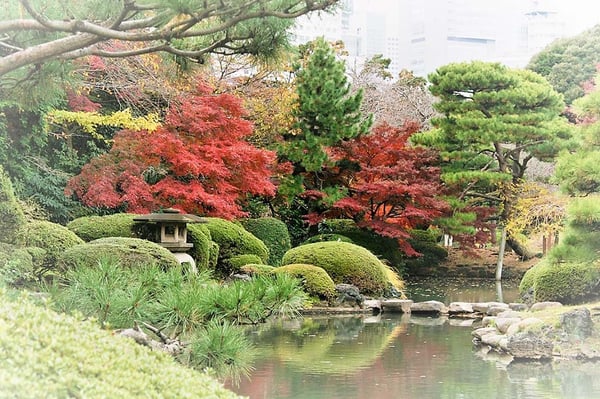
The renowned Shinjuku Gyoen, located in Shinjuku Ward, is a very extensive park, with an area of around 58 hectares. Formerly, it was the garden of the residence of Naito, who was one of the retainers of Tokugawa Ieyasu (the famous Japanese military leader), during the Edo period. There are over 10,000 trees inside the garden, with different zones of spots such as the Japanese Traditional Garden, the Landscape Garden, the Mother and Child’s Woods, as well as the Greenhouse, etc. The garden is also famous for its Sakura and maple tree scenes in spring and autumn.
|
Peak season |
Mid-November ~ Early December |
|
Open hours |
9:00 ~ 16:30 (16:00 latest entry time) |
|
Access |
10-minute walk from south exit of Shinjuku Station (JR Lines, Keio Lines, Odakyu Lines / 5-minute walk from exit 1 of Shinjuku-Gyoenmae Station (Marunouchi Line of Tokyo Metro) |
|
Admission Fee |
500 yen |
- (7) Tokyo Suginami Ward - “Otaguro Park”
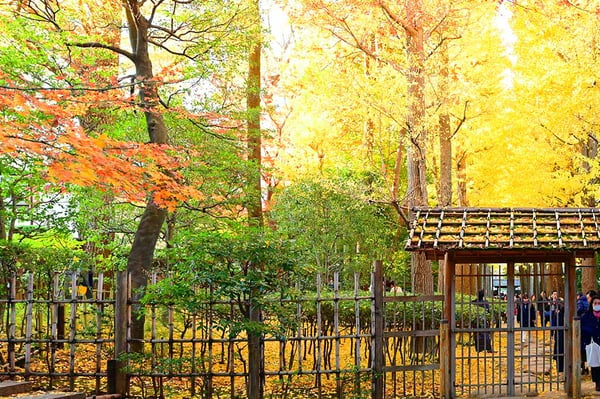
Suginami Ward is located on the west side of Tokyo, between Nerima Ward and Setagaya Ward. It was well-known as an animation industry hub, as most of the animation companies were gathered in this ward. It is mainly a residential area with several parks and shopping arcades where it is convenient for living. Suginami Ward covers a relatively large area of 34.06 square kilometers and has a population of around 590,000, ranking 8th in terms of area size and 6th in terms of population size among the Tokyo 23 wards.
Otaguro Park is one of the best spots for viewing fall foliage with its famous Japanese-style garden. It was once the residence of the famous music critic Moto Otaguro, who was a musician himself. From 1981 onwards, the park was open to the public, and Mr. Otaguro’s favorite piano remains housed in the commemorative building there.
There are over 60 maple and ginkgo trees inside the park, and some of the trees are over 100 years old! The scene of dyed red and yellow around the pond is so beautiful that it can compete with any garden in the center of Tokyo, especially with the fall foliage illumination held every late November. Going to the park is very convenient, as it is just a 10-minute walk from Ogikubo Station.
|
Peak season |
Mid-November ~ Early December |
|
Open hours |
9:00 ~ 17:00 (last garden entry time: 16:30) (The fall foliage illumination will take place from November 24 to December 4, from 17:00 to 20:00; the last entry time is 19:45.) |
|
Access |
10-minute walk from Ogikubo Station (Tokyo Metro Marunouchi Line or JR Chuo Line) |
|
Admission Fee |
Free admission |
- (8) Tokyo Katsushika Ward-“Mizumoto Park”
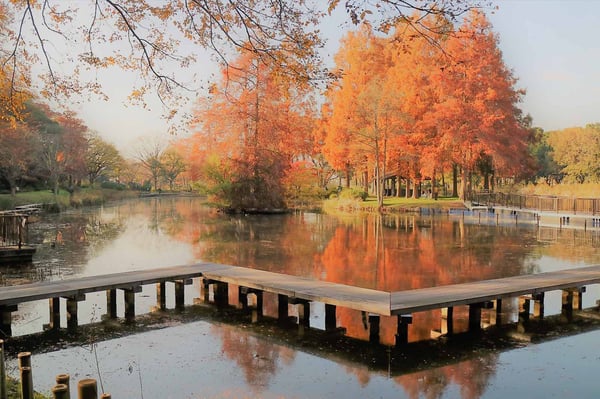
Katsushika Ward is located in the eastern part of Tokyo, adjacent to Chiba Prefecture. It is a residential area with several sightseeing spots, including Shibamata, which is well-known as the filming location of the world's longest movie series, " Tora-san’s it’s Tough Being a Man", and Kameari Park, which is the stage for the world's longest manga work - "This is the police station in Kameari Park of Katsushika Ward." Besides, Mizumoto Park is the largest park within the 23 wards of Tokyo and the only park in Tokyo with riverside town scenery. Katsushika Ward covers a relatively large area of 34.8 square kilometers and has a population of around 450,000, ranking 7th in terms of area size and 9th in terms of population size among the Tokyo 23 wards.
Mizumoto Park, located in Katsushika Ward, is the largest park within the 23 wards of Tokyo. It is also the only park in Tokyo with riverside town scenery. The park has a distinctive natural landscape filled with different kinds of trees and plants, including poplars, metasequoias, alders, Japanese irises, water lilies, and cow lilies. The park, which covers an area of approximately 963,000 square meters, has numerous amusement facilities, such as a kids' plaza, barbeque, and camping site, for families or groups to enjoy the greenery environment in Tokyo.
With over 200 poplar trees in the park that reach 20 meters in height and 1,800 metasequoias, the exciting scenery of these gorgeously colored trees offers a fabulous natural landscape in the fall. If you visit the park in the autumn, you will be amazed by its fantastic crimson and golden magical scenery.
|
Peak season |
Late November ~ Early December |
|
Open hours |
All the time |
|
Access |
7-minute walk from Mizumoto-Koen from Keisei bus stop (for bus to Togasaki-Soshajo or Nishi-Mizumoto 3-chome from Kanamachi (JR Jyoban line, JR Chiyoda line). |
|
Admission Fee |
Free |
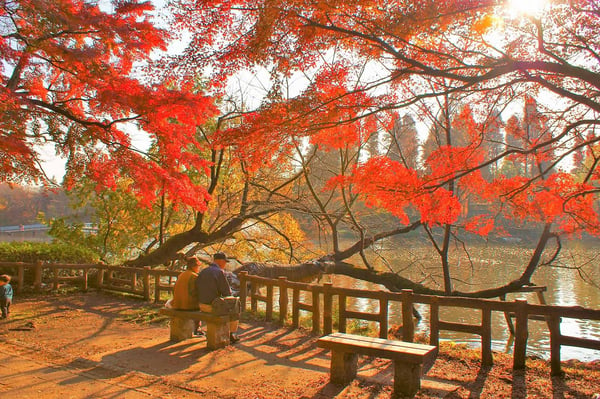
Inokashira Park is located between Musashino City and Mitaka City, which is close to the popular residential area of Kichijoji. It is one of the most popular parks in Tokyo, and the famous Ghibli Museum (for artwork by Miyazaki Hayao) is just around the corner. Over 20,000 plants and trees, such as cherry trees, Taxodium distichum, Chinese fringe tree, cypress, Carpinus tschonoskii, and maples, can be seen inside the park.
The park is divided into four sections, including Inokashira Pond and its surroundings, Gotenyama with its wooded area and Shizen Bunka-en Gardens, recreation facilities in the west end of the park, and the No. 2 park to the southeast. The landscape of the park is distinctive with its Inokashira Pond, which stretches across the park from east to west. The wooded area on the Gotenyama Terrace is made up mainly of hornbeams and oaks and is a great place for a stroll, a picnic, or even just a rest.
In autumn, the colorful reddening maples and ginkgo leaves envelop the area in a magical ambiance, which is perfect for one to take a leisurely stroll while gazing at the autumn deciduous maples.
|
Peak season |
Late November ~ Early December |
|
Open hours |
All the time |
|
Access |
5-minute walk from Kichijoji Station (JR Keio Inokashira Line) 1-minute walk from Inokashira Park Station (Keio Inokashira Line) |
|
Admission Fee |
Free |
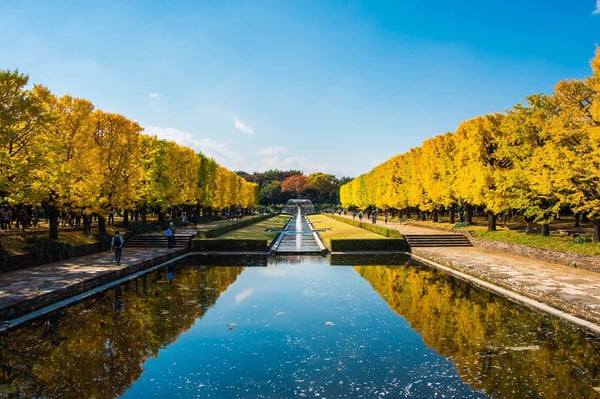
Showa Memorial Park was opened in 1983 to commemorate the 50th anniversary of Emperor Showa's reign. It is located between Tachikawa City and Akishima City, which is just 30 minutes by train from central Tokyo. The park, with over 160 hectares, comprises a variety of natural spaces, seasonal flowers, water features, museums, and sports facilities.
The park is well-known for its beautiful autumn foliage. In mid-November, the golden yellow leaves of ginkgo trees turn the 200-meter-long ginkgo-lined canal in the southeast corner into a golden avenue. It is the premier spot in the park. Together with the reddening autumn leaves of maple trees around the park, the scenery creates a magnificent image that draws crowds of people to take a snapshot to catch the memory of the arrival of autumn. For easily traversing around the park, renting a bicycle from the park might be a good way for one to enjoy various scenes inside this spacious park.
|
Peak season |
Mid-November ~ late November |
|
Open hours |
9:00 ~ 16:30 (last garden entry time: 16:00) |
|
Access |
15-minute walk from JR Tachikawa Station (JR Chuo Line) 2-minute walk from JR Nishi-Tachikawa Station (JR Ome Line) |
|
Admission Fee |
450 yen |
The above information might be helpful for those who are planning a maple viewing itinerary in Tokyo. As all these attractions are conveniently located, one can enjoy multiple autumn colors in one trip. As some basic information about the 23 wards and some suburbs of Tokyo (including Shinjuku Ward, Shibuya Ward, Chuo Ward, Bunkyo Ward, Suginami Wards, Katsushika Ward, etc.) is also provided, one might learn more about Tokyo while enjoying the maple leaves.
If you would like to learn more about property investment in Japan, please click here. >
You might have interest to read the following articles as well:
○ A guide for foreigners buying real estate in Japan.
○ What is the most updated land value in Tokyo and the changes in 5 years ?
○ NEW OR OLD? Which one is better for property investment in Japan?
○ Why Reinforced Concrete (RC) Residential Building is good for long-term investment?.
○ What are the costs incurred when buying a property in Japan?.
○ What is 1R, 1K, 1DK and 1LDK?
(REF: B-TA-E02



